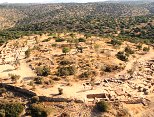 The IMFA reports: Prof. Yosef Garfinkel, the Yigal Yadin Professor of Archaeology at the Institute of Archaeology at the Hebrew University of Jerusalem, announced the discovery of objects that for the first time shed light on how a cult was organized in Yehudah at the time of Dovid Hamelech. During recent archaeological excavations at Khirbet Qeiyafa, a fortified city in Yehudah adjacent to the Valley of Elah, Garfinkel and colleagues uncovered rich assemblages of pottery, stone and metal tools, and many art and cult objects. These include three large rooms that served as shrines, which in their architecture and finds correspond to the biblical description at the time of Dovid Hamelech.
The IMFA reports: Prof. Yosef Garfinkel, the Yigal Yadin Professor of Archaeology at the Institute of Archaeology at the Hebrew University of Jerusalem, announced the discovery of objects that for the first time shed light on how a cult was organized in Yehudah at the time of Dovid Hamelech. During recent archaeological excavations at Khirbet Qeiyafa, a fortified city in Yehudah adjacent to the Valley of Elah, Garfinkel and colleagues uncovered rich assemblages of pottery, stone and metal tools, and many art and cult objects. These include three large rooms that served as shrines, which in their architecture and finds correspond to the biblical description at the time of Dovid Hamelech.
This discovery is extraordinary as it is the first time that shrines from the time of early biblical kings were uncovered. Because these shrines pre-date the construction of the Bais Hamikdosh in Yerushalayim by 30 to 40 years, they provide the first physical evidence of certain aspects of Dovid Hamelech’s reign, with significant implications.
The expedition to Khirbet Qeiyafa has excavated the site for six weeks each summer since 2007, with co-director Saar Ganor of the Israel Antiquities Authority. The revolutionary results of five years of work are presented today in a new book, Footsteps of King David in the Valley of Elah, published by Yediot Achronoth.
Located approximately 30 km. southwest of Yertushalayim in the valley of Elah, Khirbet Qeiyafa was a border city of the Kingdom of Yehudah opposite the Philistine city of Gath. The city, which was dated by 10 radiometric measurements (14C) done at Oxford University on burned olive pits, existed for a short period of time between ca. 1020 to 980 BCE, and was violently destroyed.
The absence of images of humans or animals in the three shrines provides evidence that the inhabitants of the place practiced a ban on graven images.
The findings at Khirbet Qeiyafa also indicate that an elaborate architectural style had developed as early as the time of Dovid Hamelech. Such construction is typical of royal activities of the early kings of Yisroel. These finds strengthen the historicity of the biblical tradition and its architectural description of the Palace of Shlomo.
According to Prof. Garfinkel, “This is the first time that archaeologists uncovered a fortified city in Judah from the time of King David. Even in Jerusalem we do not have a clear fortified city from his period. Thus, various suggestions that completely deny the biblical tradition regarding King David and argue that he was a mythological figure, or just a leader of a small tribe, are now shown to be wrong.” Garfinkel continued, “Over the years, thousands of animal bones were found, including sheep, goats and cattle, but no pigs. Now we uncovered three rooms, with various paraphernalia, but not even one human or animal figurine was found. This suggests that the population of Khirbet Qeiyafa observed two biblical bans – on pork and on graven images – and thus practiced a different cult than that of the Canaanites or the Philistines.”
{Read more: MFA.gov/Matzav.com Newscenter}












Durind the times of Dovid HaMelech bamos (personal alters aside from the mizbayach) were mutar, so this finding is perfectly logical according to TANACH and Chazal.
However, I object to calling this a cult.
now the arabs are gonna say it is from their leader of that time
#1, “cult” doesn’t mean what you think it means. In the study of religions, cult is the term for the system used to worship a god or gods. No negative connotations like in colloquial use.